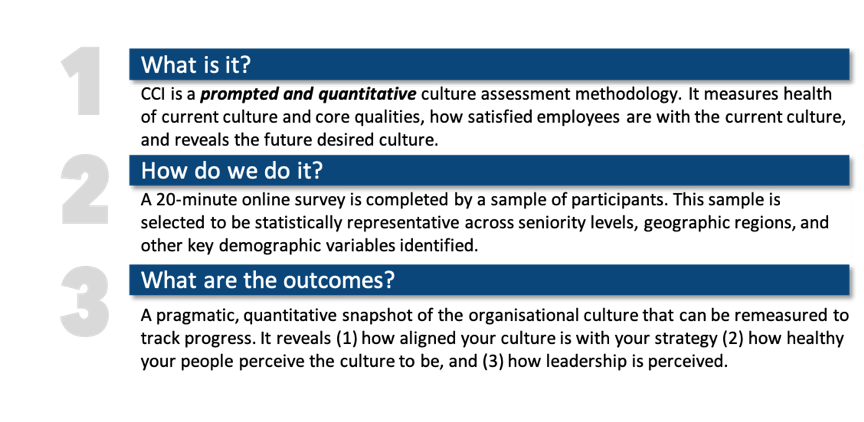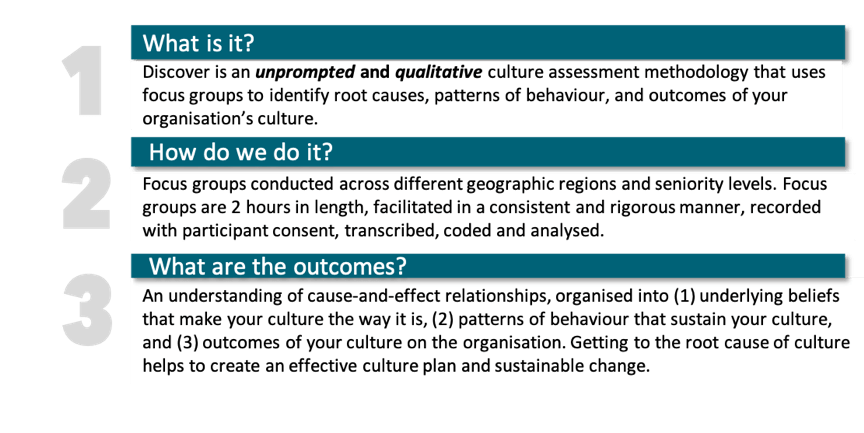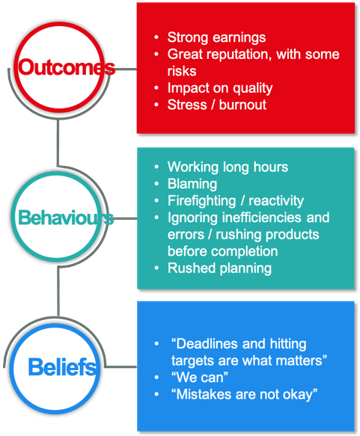Corporate culture has now become one of the key pillars on the transformation agenda of most businesses. This is because many organisations have realised that to get to the next level of growth, they will need more than just results. They need to develop effective and courageous leaders, underpinned by a culture that matches their goals and objectives. Keep reading to learn how to assess and adapt your culture in 3 simple steps.
Essentially, an organisational culture assessment gives you a clear picture of what your current culture ecosystem looks like. It helps you to identify any potential blockages, which may prevent development and innovation. Additionally, it can help you spot any weak spots or opportunities for growth.
You need to look at two important aspects when assessing your culture:
Using tools to assess your culture can help you discover areas of untapped potential, and positive behaviours you want to encourage. It can also help you identify issues and pain points, or areas that are being neglected. Without a clear understanding of your current structure, any changes you make will be uninformed. This will potentially lead to additional time and resources being wasted when focus is put into the wrong areas.
Measuring and adapting your culture using person-centric and data-driven insights can drive your business towards success and innovation. Potential benefits include:
All of this, in turn, will also lead to increased customer satisfaction, due to the higher quality output.
In your assessment, the categories you need to focus on are the behaviours, symbols, processes, and systems. Examples of potential areas for assessment and improvement include:
It can be difficult knowing where to get started, so we have compiled a step-by-step approach to measuring the success of your organisation, and how to analyse the results to change it for the better:
The first step when embarking on a culture journey is to assess the current state of the culture. Many leaders and employees will be able to describe their experience of the culture, but what is important in culture is patterns, not the experience of isolated individuals. Those patterns can only be uncovered when the diagnostic is broad enough.
Be clear about why you want to assess your culture, because it will dictate what tool you should be using. At Walking the talk, our recommendation is to use both a survey and a focus group approach to get a detailed description of your current culture, as well as the reasons that sit behind it.
DOWNLOAD OUR MEASURING CULTURE EBOOK
If you think you need to change the culture of your organisation, it is essential to first understand what the existing culture looks like. This means taking a snapshot of the behaviours and mind-sets that are the norm in the organisation. By recognising the current culture, you can then determine the extent to which it is an asset or a liability, given the business imperatives ahead. This work is descriptive in nature.
Quantitative research can be used in this case. It will give you a good broad-brush picture of the current culture. For example, whether people see collaboration, or innovation, or keeping their word as common cultural characteristics. You can even see the extent to which damaging behaviours such as blaming, poor safety disciplines, or avoiding risks are tolerated. This will then allow you to clearly visualise what the future will look like, and the best possible solution to get there.
The best tools to do this are surveys. When considering the use of a survey, it is critical to think about the following points:
Many surveys try to do too much and measure too many dimensions, which often results in analysis-paralysis. They produce complicated sets of data that need weeks to analyse and are hard to turn into simple actions. Effectiveness when working on culture is about choosing simplicity. You want to develop simple, measurable actions that will shift the culture.
One weak point of culture surveys is that they frequently focus on cultural attributes, such as agility, collaboration, competition, or pride, but not so much on the behaviours themselves. However, it is the behaviours that make culture tangible and do-able. Clearly identifying the behaviours displayed by employees is therefore critical.
Confusing engagement with culture is incredibly common; engagement is often used as a proxy for managing culture. Essentially, engagement is the motivation that people have to do their best, whereas culture is how they do it. Engagement is often an outcome of culture, and an indicator of its success. If your desire is to work on culture, then use a culture survey, not an engagement survey.
At Walking the Talk, our Culture Insights survey measures 90 detailed behaviours across six cultural archetypes, and three core qualities of courageous leadership for healthy cultures.
Our survey helps you understand your current culture in terms of attributes and behaviours, and it enables you to compare it with your target culture to measure the gap between the two. The measure of the three core qualities in your leadership give you an insight into the organisation’s preparedness for culture change.

If you can describe your culture but don’t know what drives it, your interventions will be generic and scattered. The more detail you have on the ‘why’ of your culture, the better you will be able to plan for and implement interventions to build the culture you want.
Root cause analysis requires a qualitative approach; quantitative research is rarely enough. For example, quantitative research may reveal a culture where people avoid speaking up. However, the cultural drivers behind a lack of speaking up are numerous: fear of getting into trouble, a desire to respect elders, or because people are disengaged and feel they are never listened to. The approach to changing the culture is different for each, and so must depend on understanding the root cause through qualitative research.
The best tools to do this are focus groups, interviews, and discussions.

To get the most out of your focus group, a clear and effective methodology that suits your processes and goals is vital.
For example, at Walking the Talk, our deep-diving focus group methodology is called DISCOVER. Focus group discussions are led by the group and prompted by the facilitator. They are built on the premise that what people choose to talk about is what they value, and what is important to them. So, if, for example, you have 30 hours of recorded discussions and customers are only mentioned 10 times, it probably means that customers are not front-of-mind. This suggests that customer-centricity may be low across the board, and is a potential focus area going forward.

Our methodology helps you develop a description of what happens in the business and what behaviours are being displayed. It will help you visualise what symbols and systems are being used to reinforce the messages, whether consciously or not. Importantly, it also gives you the belief system shared by employees, including the lynchpin beliefs, and their impact on the business.
For further insights, view our selection of case studies, ebooks, reports & white papers, or contact us to learn how we can transform your culture.
Essentially, an organisational culture assessment is a testing process that helps you define your current company culture and your goals. This is done with a view to creating a plan to change it so that you can create the behaviours and processes you wish to see.
Examples of cultural assessment tools include surveys and focus groups. These will help you get bespoke feedback in relation to your current organisational processes. You can see an example of findings from an assessment survey such as ours below:



Head Office / Europe:
+31 (0) 20 240 2233
North America:
+1 (0) 212 417 0221
UK: +44 (0) 207 100 6999
Asia Pacific: +61 (2) 8310 5285
Brazil & Latin America: +55 (11) 932 500 683
(WhatsApp available)